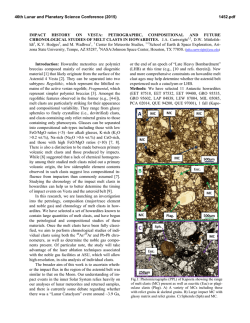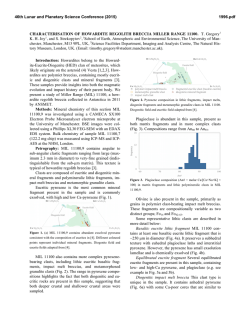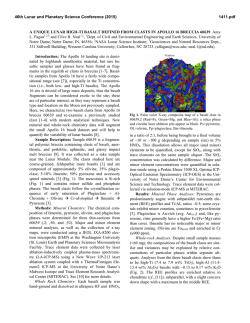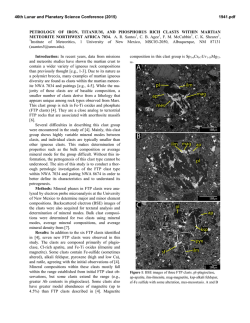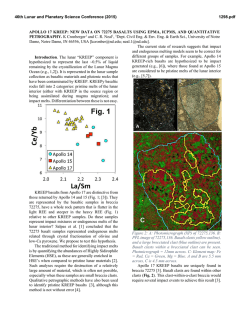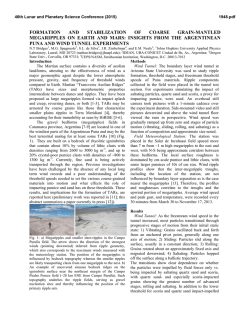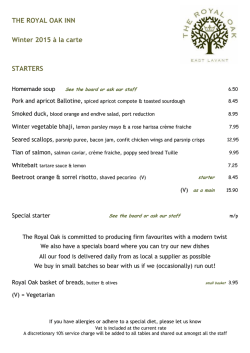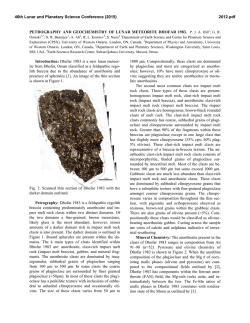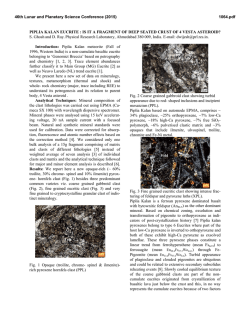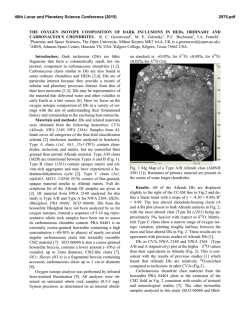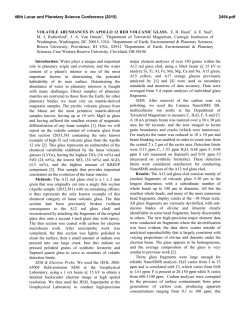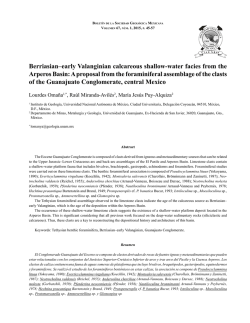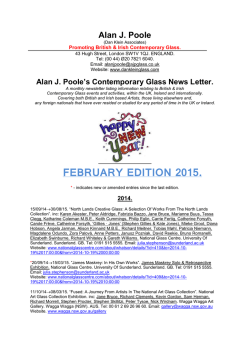
Previously unrecognized impactites from the Steen River impact
46th Lunar and Planetary Science Conference (2015) 2592.pdf Previously unrecognized impactites from the Steen River impact structure, NW Alberta, Canada: A new variety of suevite? E. L. Walton1,2, A. H. Hughes2 and C. D. K. Herd2, 1MacEwan University, Department of Physical Sciences, Edmonton, AB, T5J 2S2, Canada ([email protected] / [email protected] ), 2University of Alberta, Department of Earth & Atmospheric Sciences, Edmonton, AB, T6G 2E3, Canada. Introduction: The Steen River impact structure (SRIS; 59o31'N, 117o39’W) is a buried complex crater first detected as an anomaly on magnetic and seismic surveys in the 1960s. Originally described as a volcanic cryptoexplosion crater it was subsequently ascribed to hypervelocity impact based on the presence of shock deformation and transformation features in quartz and feldspar [1,2]. Target rocks include a 70 m layer of Mississippian calcareous shale underlain by ~1530 m of Devonian (Wabamun Group, Hay River shale and Elk Point Group). This ~1.6 km thick sequence of sedimentary rocks overlies granites and granitic gneisses of the Precambrian basement. With a roughly elliptical shape, quoted as ~25 km diameter in its longest dimension, SRIS is the largest known impact structure in the Western Canada Sedimentary Basin and is an oil and gas producer and reservoir host [3]. A central uplift measuring 4 km at its top raises fractured basement above regional levels [3]. The crater age, reported as 95 ± 7 Ma, is based on a single K-Ar whole rock age obtained from a ‘pyroclastic vesicular rock’ [1]. Here, the results of a combined SEM, EMPA and Raman spectroscopic study of a suite of impactites from the SRIS are reported. Over 120 m of clast-rich impactite is described, which may represent a new and previously unrecognized variety of melt-bearing impact breccia, similar to but distinct from suevite described from other similar-size impact structures where sedimentary targets outweigh crystalline rocks (e.g., Ries). Sample Selection and Anaytical Methods: In early 2000, New Claymore Resources Ltd drilled three continuous but shallow diamond drill holes into the crater fill deposits of the SRIS (ST001, ST002, ST003). One hole (ST003) penetrated the central uplift; holes ST001 and ST002 were drilled into the annular trough. ST003, previously logged in detail by [4], has been re-visited in this study, systematically logged and sampled. A total of 44 polished thin sections from ST003 were prepared for petrographic analysis. Microtextures and mineral composition was characterized using a Zeiss EVO MA LaB6 filament SEM in BSE imaging mode. Major and minor element abundances of minerals and glass were analyzed with a JEOL 8900 EMPA. Raw data were corrected using the ZAF procedure. Sample names in the following description refer to depth (in meters). Results: General core description: The uppermost portion of core is lower Cretaceous marine shale, which is not the subject of this study. A depth of 205.4 m marks the boundary between the overlying shale unit and underlying proximal allochthonous impactites. The upper 7 m is friable with a pale grey colour containingvisible (<1 cm) matrix-supported lithic clasts of carbonates and lesser amounts of granitic material. Impact glassy clasts are noted but are not abundant. Carbonates (clasts and in the matrix) dominate the core between 205.4‒212 m. At 212 m the core takes on a distinctive tan appearance, becomes more compact and the clast population changes from limestone-dominated to crystalline basement-dominated. Amoeboid light grey to white impact glass (1‒2 cm) clasts become abundant, oriented roughly perpendicular to the length of the core. The impactites develop a distinctive reddish to violet tinge that begins around 225.5 m depth; this coloration increases in intensity to 240 m. Here, the core takes on a green colour which is observed to the bottom of the hole (terminated at a depth of approximately 377.4 m), with the exception of a few meters of core (sampled at 365 m) which is very dark and glassy. The clast population in this interval (240‒377.4 m) is dominated by crystalline target rocks and impact glass. In general the size and abundance of lithic clasts increases with depth; the bottom ~10 m of ST003 is granitic and granitic gneisses crosscut by networks of melt-bearing breccia and shear-induced veins (see Walton et al. companion abstract for an inventory of high-pressure minerals associated with SRIS shock veins). The green impactites occuring between 240‒367 m, described by [4] as a “micro-breccia with glass fragments” was the subject of detailed petrographic characterization, as described in the following paragraphs. Matrix of green impactites (240‒367 m): The matrix contains ~60 vol% crystals, embedded in a groundmass of secondary alteration products (clays). It is presumed that the matrix clay once consisted of primary glass, but has now-altered to clay. The mineralogy is dominated by pyroxene + sanidine + albite (360 µm crystals; avg = 15 µm, n = 300). All crystals have a poikilitic texture. Pyroxene occurs as prismatic, euhedral to subhedral augite and diopside (En18-48Fs333Wo42-50) enclosing tiny 5 µm to ≤1 µm euhedral crystals of feldspar (plagiclase and sanidine) and ilmenite. Most pyroxenes are zoned (core-rim zoning or patchy / irregular zoning). Plagioclase (An1-42Ab54-99Or0-7) and sanidine (An1-4Ab9-29Or66-88) also occur as larger euhe- 46th Lunar and Planetary Science Conference (2015) dral to subhedral single crystals. These larger feldspar crystals enclose smaller euhedral augite and ilmenite. Ilmenite forms a volumetrically minor but ubiquitous component of the samples studied, observed as tabular crystals (12‒45 µm length) enclosing or partially enclosing smaller grains of clinopyroxene and albite. In addition to the pyroxene + feldspar + ilmenite crystals disseminated throughout the matrix, heterogeneous clumping of crystals or crystal clusters occur either as a corona surrounding clasts (subsequently replaced by clays) or clasts which have been completely replaced. These include euhedral magnetite, titanite, garnet and pyroxene + plagioclase + ilmenite assemblages. Garnets are equant 10‒60 µm size crystals of green grossular (Ca2.97Mg0.03)(Al1.2Fe3+0.80)(Si2.96Al0.04)O12, zoned to andradite (Ca2.96Fe0.02Mn0.01) (Fe3+1.82Al0.15Fe2+0.01Si0.01)Si3O12 or andradite single crystals. Some clasts have been completely replaced by pyroxene + plagioclase + ilmenite ± alkali feldspar, forming local “basaltic” granular clasts in the matrix. Clast population (240‒367 m): The clast component comprises variably shocked lithic and mineral fragments (quartz > feldspar > biotite (decomposed) and abundant impact glass clasts. Quartz clasts are brown or colourless with planar fractures, planar deformation features (up to three sets with distinct crystallographic orientation) and exhibit weak to moderate mosaicism. One sample (365 m) contains clasts of ballen quartz corresponding to type V of [5]. Raman spectra show the prominent peak of α-quartz at 464 cm-1. Feldspar clasts in the matrix are highly altered and may only be identified as albite or sanidine by remnant twinning or bulk composition from EDS raster scans. Impact glass (now devitrified) occurs as individual matrix-suppported clasts typically in enlongated, schlieren-rich, flow-textured, vesiculated forms or as thin to thick films (up to 8 cm thick) coating, and intruding into, lithic clasts. In general the long axis of impact glass is orientated roughly perpendicular to the length of the core. A thicker 2.1 m interval (not sampled) of glass occurs at ~358‒360 m depth. Colourless, opaque, red, reddish-brown and grey glass varieties are observed. All are holohyaline or hypocrystalline, the latter containing skeletal pyroxene or albite microlites. The contact between glass clasts and surrounding matrix ranges from sharp to gradational. The impact glass clasts themselves contain clasts which are heavily altered but appear to have been originally quartz, albite, alkali feldspar and biotite. High-temperature (>1750 °C) effects such decomposition of zircon to baddelyite + silica glass, have been found in glass clasts. Discussion: The overall texture of variable shocked mineral fragments and abundant often contorted glassy 2592.pdf clasts is similar to “suevite” (melt-bearing impact breccia) described from other small to medium size craters (e.g,. Brent) and those formed in mixed target rocks (e.g, Ries). However, the matrix of suevites may range from fine-grained clastic material to altered glass. The observed microporphyritic texture which defines the groundmass of the ~127 m thick meltbearing, clast-rich impactites described here from the SRIS may have formed by a high degree of thermal metamorphism of an otherwise extremely fine-grained superheated clastic matrix. This is supported by the identification of garnet (grossular-andradite) within the matrix, long recognized as minerals typical of skarns and other high temperature contact metamorphic deposits. The impactites incorporated a large fraction of variably shocked clasts, ranging from completely molten (glass clasts), to variably shocked materials. The more strongly shocked clasts with high post-shock temperatures were more easily assimilated, forming reaction coronas, or in some cases being completely decomposed. The less strongly shocked clasts exhibit diagnostic shock effects such as PDFs but were colder and did not serve as nucleation sites within the melt (i.e., they lack reaction coronas). Impact glass is an important component occurring as individual clasts or as coatings associated with larger (decimeter-size) lithic clasts (granitic). Because clay has replaced the original glassy groundmass in the matrix it is impossible to compare the matrix glass composition to that of the impact glass clasts; however, the fact that the melt quenched to glass implies rapid cooling rate (inhibiting crystal nucleation and growth) and / or a more Si-rich composition in which the high viscosity of the melt inhibited crystallization. The same green impactites described in detail here were observed by [4] from ST001 and ST002, suggesting that the ~127 m thick deposit extends laterally for at least 13.8 km. Conclusions: This research demonstrates the merit of revisiting understudied, and therefore underappreciated, impact structures. The pyroxene + sanidine + plagioclase + ilmenite crystals in the matrix of allothonous impactites at the SRIS could have formed from a high degree of thermal metamorphism of an extremely fine-grained superheated dust. These rocks possess a similar texture to “suevite” (melt-bearing clastic matrix breccia) deposits described from other impact structures but the unique nature of the matrix may required a new term for such deposits as a variety of suevite. References: [1] Carrigy and Short, 1968. Shock Meta. Nat. Materials, pp. 367-378. [2] Winzer, 1972. 24th Int. Geol. Congress Proc., pp. 148-156 [3] Grieve, 2006. Impact structures in Canada, pp.210. [4] Molak et al., 2002. AEUB OFR Earth Sci. Report 2001-04. [5] Ferriere et al. 2009. Eur. J. Miner. 21; 203-217.
© Copyright 2025
